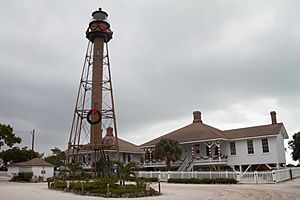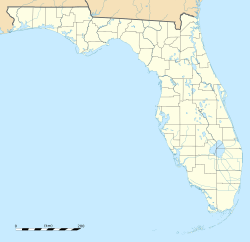Sanibel Island Light facts for kids
 |
|
| The Sanibel Island Light Station in 2019 | |
|
|
|
| Location | East end of Sanibel Island |
|---|---|
| Coordinates | 26°27′10.6″N 82°0′51.4″W / 26.452944°N 82.014278°W |
| Year first lit | 1884 |
| Automated | 1949 |
| Foundation | iron pile |
| Construction | iron |
| Tower shape | Square, pyramidal, skeleton, iron framework, inclosing stair-cylinder and surmounted by lantern |
| Height | 98 feet (30 m) feet (102 feet (31 m) above sea level) |
| Original lens | third order Fresnel lens |
| Characteristic | 1901: fixed white varied by a white flash every 2 minutes; 1933: two grouped white flashes every 10 seconds |
| Admiralty number | J3086 |
| ARLHS number | USA-734 |
| USCG number | 3-1245 |
The Sanibel Island Light, also called Point Ybel Light, is a famous lighthouse in Florida. It was one of the first lighthouses built on Florida's Gulf coast. This light helped guide ships north of Key West and the Dry Tortugas.
The lighthouse stands 98 feet (about 30 meters) tall. It is made of an iron skeleton tower. The light was first turned on in 1884. Inside, there is a spiral staircase that starts about 10 feet (3 meters) above the ground. The lighthouse is located at the eastern tip of Sanibel Island. Its main job was to mark the entrance to San Carlos Bay. This helped ships find their way to the port of Punta Rassa. Punta Rassa is across San Carlos Bay from Sanibel Island. You can visit the lighthouse grounds, but you cannot go inside the tower itself.
Contents
History of the Sanibel Light
People living on Sanibel Island first asked for a lighthouse way back in 1833. But nothing happened for a long time. In 1856, the United States Lighthouse Board suggested building a lighthouse on Sanibel Island. Still, the United States Congress did not approve it.
Finally, in 1877, government workers surveyed the eastern part of the island. They set it aside for a future lighthouse. Congress finally gave money for the lighthouse in 1883. The base for the new lighthouse was finished in early 1884.
Building the Tower
Something unexpected happened while the lighthouse was being built. The ship carrying the iron parts for the tower sank! It went down about two miles (3 km) from Sanibel Island. A team of hard-hat divers from Key West came to help. They worked underwater to get almost all the pieces back. Only two parts were lost.
Punta Rassa's Importance
Punta Rassa became a very important port in the 1830s. It stayed important until the Spanish–American War. It was mainly used to ship cattle from Florida to Cuba. Before railroads reached the area in the 1880s, ranchers would drive their cattle. They brought them from open ranges in central Florida to Punta Rassa. From there, the cattle were shipped to Cuba.
Lighthouse Today
The Sanibel Island Light was added to the National Register of Historic Places in 1974. This means it is a special historical site. Today, the City of Sanibel owns the land and buildings around the lighthouse. However, the tower itself is still working. It is controlled by the United States Coast Guard.
Lighthouse Keepers
A lighthouse keeper was a person who lived at the lighthouse and made sure the light was working properly. Here are some of the people who kept the Sanibel Light shining:
- Dudley Richardson 1884 – 1892
- Henry Shannahan 1892 – 1913
- Charles Henry Williams 1913 – 1923
- Eugene Shanahan 1924 – 1926
- William Demere 1926 – 1932
- Roscoe McLane 1932 – 1935
- Richard J. Palmer 1935 – 1946
- William Robert England 1946 – 1949
Images for kids
- McCarthy, Kevin M. (1990). Florida Lighthouses, Paintings by William L. Trotter, Gainesville, Florida: University of Florida Press. ISBN: 0-8130-0982-0.





